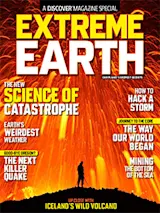This article is a small sample from
DISCOVER's special issue Extreme Earth.
photograph by Misha Gravenor | NULL
Planetary scientist David Stevenson has spent three decades studying the gigantic collisions and geologic cataclysms that created the planet we call home. His discoveries have helped answer some of the biggest questions about Earth’s formation, structure, and evolution. We know that the planet has a partly solid, partly liquid core, composed largely of iron, surrounded by a thick, flowing mantle, topped by a thin layer of crust. Still, we are surprisingly ignorant about our planet’s deep structure, says the 63-year-old New Zealand native. Hoping to learn more, he contributed ideas for NASA’s Juno mission, which blasted off in August. The spacecraft will orbit Jupiter to study its interior, which may indirectly reveal insights about Earth as well—such as how the core was formed, where our planet’s magnetic field came from, and why ...














